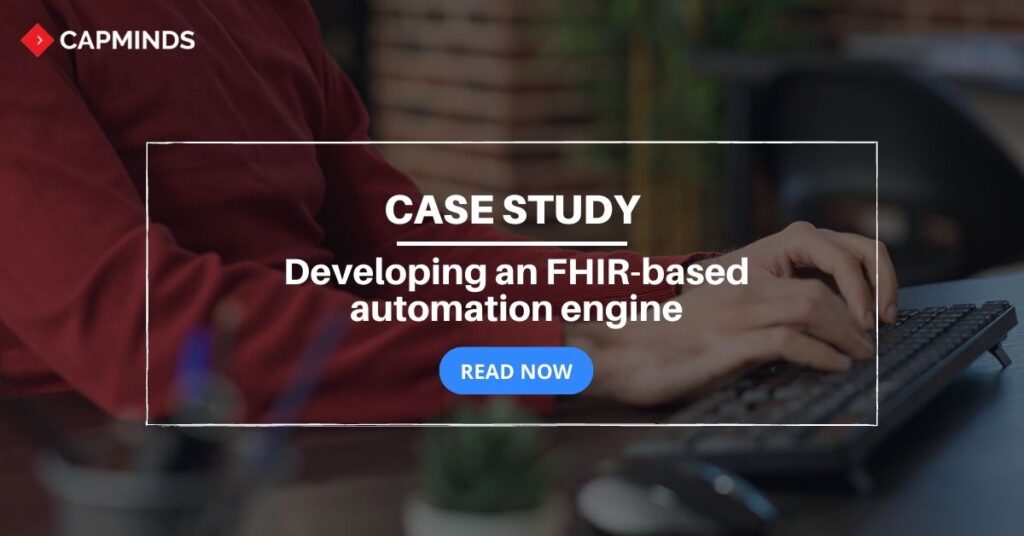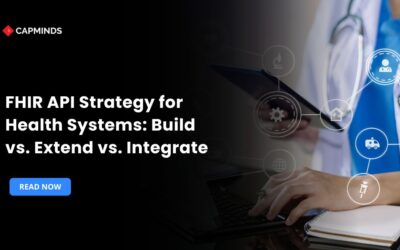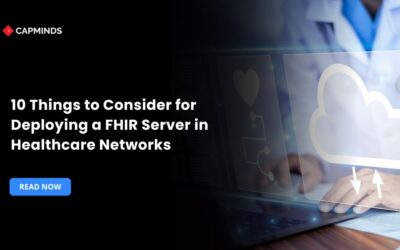Case Study: Developing an FHIR-based automation engine
Client Overview
An automation engine was one of the projects CapMinds developed for a client, one of the largest TPAs in the USA which provides operational services, such as claims processing for all the major health insurance companies in the USA, and exchanges data with the key health providers in the region.
Business Challenges
As one would expect for a TPA (or any other administrative or operational services company), greater efficiency and cost reduction are crucial for the business. Automation can help with that, but it’s easier said than done. The main workload of TPAs is carried by the adjusters, who should have vast expertise and deep knowledge of the logic, rules, constraints, etc. of the services they are responsible for administering.
One complication is that such logic, rules, and constraints (which constitute the insurance plans) are usually stored as non-structured, non-formalized, and fragmented data. The same applies to patients’ claim histories from various providers.
Therefore, to unlock the automation part of automation, the CapMinds team first needed to resolve two quite complex issues:
- Unification of the data exchange from different providers and insurers – this was solved by mapping custom data structures to FHIR standards and by developing custom profiles for Coverage, Coverage Eligibility Request, Coverage Eligibility Response, Claim (for claims, predetermination, and pre-authorization), Claim Response, etc.
- Formalization and structuring of the insurance plans so the client could support automatic adjudication later – this was the starting point in the development of the automation engine this case study is dedicated to.
- There was no prior experience in FHIR by both the client and the stakeholders.
- The manual claim/pre-auth processing flow is quite complicated; a large degree of the knowledge is verbal.
- Some of the data used or referenced in this project already existed in a custom proprietary format. It was crucial to leave it as is to support the business
- Process continuity.
RELATED: Case Study: Integrating HL7, FHIR, & API Capabilities with CapMinds
Our Approach
CapMinds task of automating claim adjudication included processing the list of required healthcare services to determine which of them could be covered by insurance and to what extent. The adjudication process is essential for the input claim processing or pre-authorization performed by the insurance company or TPA.
The client wanted to decrease the time spent by the assistance department on patients’ claim processing. This would boost efficiency and reduce the cost of claim processing.
Phase 1 – Business Analysis
Duration: 2 weeks
The CapMinds team started with the business analysis (discovery) phase. The ultimate outcome of this phase was an understanding of the business domain, its core concepts, and processes. From the process perspective, the team collected all the available paper-based insurance plans, contacted TPA adjusters, and discussed all the particular details with them.
It was important to gather as much information as the team could physically process and not miss anything that might become crucial later.
Phase 2 – Design and structuring
At this stage, the design was implemented from the input collected in Phase 1. The team built a domain-specific model covering the requirements, i.e., how indemnity plans differ from managed care plans from the data and process perspective, how limits and constraints work (deductibles, co-pays, co-insurance, out-of-pocket maximums, etc.), and how to store the insurance plans and patient claim history.
The same was applied to the business data being exchanged: Coverage, Coverage Eligibility Request, Coverage Eligibility Response, Claim, Claim Response, etc. For all of them, mapping to the currently existing documents was conducted, and FHIR profiles were created.
Phase 3 – Implementation
Duration: 4 weeks
Next, CapMinds began to design the technical implementation. From the technical standpoint, the team implemented the following:
- API for insurance plan management (for the insurance companies to consume)
- API for bulk import/export of the insurance plans (.yaml files were used)
- UI for insurance plan management
- FHIR-based API for the eligibility check
- UI for the eligibility check
- FHIR-based API for pre-auths, predetermination, and claims
- UI for pre-auths, predetermination, and claims
The most complicated part was automation, as it involved claims (preauthorization or predetermination), patient insurance plans, and patient claim history as input.
Technology stack:
- React,
- TypeScript,
- Mongo DB,
- Kubernetes.
The Outcomes
The client received a fully functional FHIR-based automation engine. It is essentially a rule engine, supporting the plans with their complex limits and constraints: deductibles, co-pays, co-insurance, out-of-pocket maximums, family limits, min/max patient age, etc.
FHIR services from CapMinds
CapMinds’s extensible and flexible architecture ensures that the company going forward will be able to integrate with electronic healthcare records HL7 2.x messaging, share data via APIs, and be FHIR interoperable if required. CapMinds also supports HL7 2.x, HL7 3.x, FHIR, CDA/C-CDA, X12 EDI, NCPDP, DICOM, and more.
CapMinds Technologies offers the perfect all-in-one Interoperability solutions for your clinical needs. Our HL7 integration and FHIR standards services facilitate the innovatory exchange to create new possibilities, client-centered services for keeping our clients in the limelight, clinical integrations facilitate EHR integrated laboratory, imaging, e-prescriptions, EPCS, pharmacy, and more and enhance the activation process for your individual and collective needs.
“Reduce your overbearing challenges and step towards a higher functionality by choosing CapMinds Technology”




